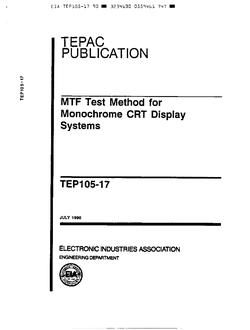-
-
Available Formats
- Availability
- Priced From ( in USD )
-
Available Formats
-
- Secure PDF 🔒
- Immediate download
- $95.00
- Add to Cart
-
- Immediate download
- $95.00
- Add to Cart
-
- Printed Edition
- Ships in 1-2 business days
- $95.00
- Add to Cart
Customers Who Bought This Also Bought
-

ECIA EIA-198-1-F
Priced From $95.00 -

ECIA RS-186-10E
Priced From $68.00 -

ECIA RS-333
Priced From $30.00 -

ECIA 213
Priced From $68.00
About This Item
Full Description
MTFs FOR MONOCHROME CRTs
Background
In most cases, the interface between humans and machines is a visual display.
The sharpness and readability of raster-scanned Cathode-Ray Tube (CRT) displays conventionally has been determined by how far the vemcal raster height could be reduced while still displaying individual scan lines (Shrinking Raster Line Width Measurement). This method yields a rough "order-of-magnitude" estimate of the visible raster-line capacity of a display device.
As user demands for display readability increase, the subjectivity and over-simplification of this technique limits its practical utility for precise engineering specifications. A more definitive method of measuring the true beam spread is needed to describe the complete display performance. The measurement of line width by a scanning photometer removes a great deal of the subjectivity from this type of measurement. in this method, a measurement is made of the light distribution across the width of a single raster-he. This measurement reveals the true profile of light intensity across a raster-line in an objective manner. The line profile, in tum, usually is designated by its full-width at 50% of its peak light intensity or luminance.
Moreover, continual user demands for better image quality through increased pixel density has underscored the need for more descriptive methods of assessing the total imaging capability of a CRT display. A quantification of the accuracy achieved in reproducing the input signal on the viewer's screen is the ultimate goal. The preferred specification to describe this performance characteristic of a CRT display is the Modulation Transfer Function (MTF).
The MTF takes into account not only the raster-line width at one specific percentage of peak intensity, but also accounts for the entire line profile shape. It can be shown analytically that the shape of the raster-line profile as well as the beam width are evaluated in the MTF. Phosphor screen spreading, reflections from the phosphor and optical coatings, as well as saturation effects of the screen also affect to the MTF.
An additional advantage of the MTF measurement is that other elements of the display system may be incorporated into the evaluation, and thus, provide a composite MTF specification for the total display system. The MTF usually is presented as a curve representing modulation transfer across the spatial frequency bandpass of the display device or system.
One method to evaluate the MTF is to drive a CRT grid or cathode with a sine-wave signal. Synchronized with an appropriate raster-scan, typically 525 lines, bright-to-dark sine-wave bars are generated on the display screen. Reference conditions can be selected to assure full-on and full-off performance of the display. The bright and dark bars are scanned with a slit-aperture photometer such as that described in EIA Test Method 105-7.
Statement of Purpose
The purpose of this test method is to provide a procedure to compute the MTF of monochrome CRTs in order to quantify the discemability and quality of displayed information. While the mathematical concepts of the MTF are complex, this test method provides a software package which aiiows users to easily convert spot profile data into MTF data., There is no need for mathematical calculations by the user. The software package is designed for use on any computer system with a standard FORTRAN-77 compiler, and a second version of the software for an IBM-PC (or lûû%-compatibles) personal computer provides graphical presentations of the spot profile and associated MTF data.





